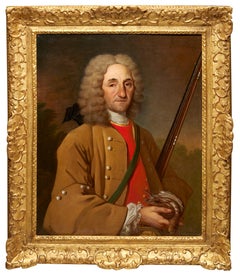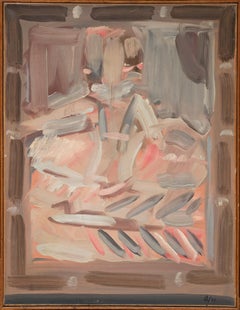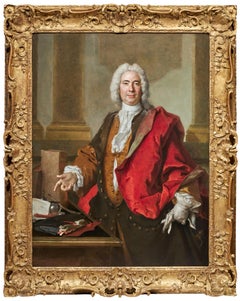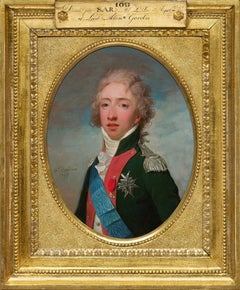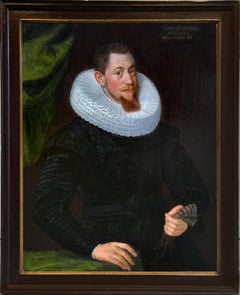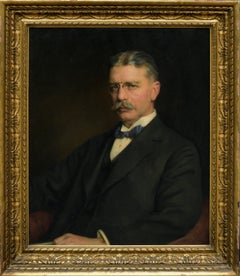Stephane Renard Fine Art Portrait Paintings
to
1
1
1
2
Overall Width
to
Overall Height
to
4
1
1
3
4
1
5
4
4
3
2
2
1
1
1
1
5
5
3
3
1
1
5
5
Portrait of Julien Prieur the bailiff of the Marquis d'Armentières as a Hunter
By Jean-Baptiste Oudry
Located in PARIS, FR
This portrait depicts us the trusted confidant of the Conflans d'Armentières family. More precisely, Julien Prieur was the fiscal procurator of the Marquisate of Armentières, playing...
Category
1730s Old Masters Portrait Paintings
Materials
Canvas, Oil
Infanta - Study Number 6, a 1960 painting by Fermin Aguayo after Velázquez
Located in PARIS, FR
Initialled and dated lower right "a/60", countersigned and dated on the back "aguayo 60".
A breath of modernity animates this iconic work, inspired by Velázquez' portrait of the Inf...
Category
1960s Modern Portrait Paintings
Materials
Canvas, Paper, Oil
Portrait of Monsieur Aubert, a ceremonial portrait by Nicolas de Largillière
By Nicolas de Largillière
Located in PARIS, FR
Provenance :
Arnold S. Kirkeby (1901-1962)
Donated by Arnold S. Kirkeby to the Los Angeles County Museum of Art in 1955, where it remained until its sale at Sotheby's, New York on Ja...
Category
1720s Old Masters Portrait Paintings
Materials
Oil
Two royal portraits (the Duc d'Angoulême and the Duc de Berry) by H.P. Danloux
Located in PARIS, FR
These two royal portraits are a major historical testimony to the stay of the Comte d'Artois (the future Charles X) and his family in Edinburgh in 1796-1797. Given by the sitters to Lord Adam Gordon, the Governor of Edinburgh, and kept by family descent to this day, these two portraits provide us with a vivid and spontaneous image of the Duc d’Angoulême and his brother the Duc de Berry. Danloux, who had emigrated to London a few years before, demonstrate his full assimilation of the art of British portrait painters in the brilliant execution of these portraits.
1. Henri-Pierre Danloux, a portraitist in the revolutionary turmoil
Born in Paris in 1753, Henri-Pierre Danloux was first a pupil of the painter Nicolas-Bernard Lépicié (1735 - 1784) and then, in 1773, of Joseph-Marie Vien (1716 - 1809), whom he followed to Rome when, at the end of 1775, Vien became Director of the Académie de France. In Rome he became friends with the painter Jacques-Louis David (1748 - 1825).
Returning to France around 1782, he settled in Lyon for a few years before returning to Paris in 1785. One of his first portraits was commissioned by the Baroness d'Etigny, the widow of the former Intendant of the Provinces of Gascony, Bearn and Navarre Antoine Mégret d'Etigny (1719 – 1767). He then became close to his two sons, Mégret de Sérilly and Mégret d'Etigny, who in turn became his patrons. In 1787, this close relationship with the d'Etigny family was further strengthened by his marriage to Antoinette de Saint-Redan, a relative of Madame d'Etigny. After his marriage, he left for Rome and did not return to France until 1789. It was during the winter of 1790-1791 that he painted one of his masterpieces, the portrait of Baron de Besenval. Set in a twilight atmosphere, this portrait of an aristocrat who knows that his death is imminent symbolizes the disappearance of an erudite and refined society which would be swept away by the French Revolution.
The Jacobin excesses led Danloux to emigrate to England in 1792; many members of his family-in-law who remained in France were guillotined on 10 May 1794. Danloux enjoyed great success as a portrait painter in England before returning to France in 1801.
During his stay in England, Danloux was deeply under the influence of English portraitists: his colors became warmer (as shown by the portrait of the Duc d'Angoulême that we are presenting), and his execution broader.
2. Description of the two portraits and biographical details of the sitters
The Duc d'Angoulême (1775-1844) was the eldest son of the Comte d'Artois, the younger brother of King Louis XVI (the future King Charles X), and his wife Marie-Thérèse of Savoie. He is shown here, in the freshness of his youth, wearing the uniform of colonel-general of the "Angoulême-Dragons" regiment.
He is wearing the blue cordon of the Order of the Holy Spirit, which was awarded to him in 1787, and two decorations: the Cross of Saint-Louis and the Maltese Cross, as he was also Grand Prior of the Order of Malta.
Born on 16 August 1775 in Versailles, Louis-Antoine d'Artois followed his parents into emigration on 16 July 1789. In 1792, he joined the émigrés’ army led by the Prince de Condé. After his stay in Edinburgh (which will be further discussed), he went to the court of the future King Louis XVIII, who was in exile at the time, and in 1799 married his first cousin Marie-Thérèse Charlotte of France, the daughter of Louis XVI and the sole survivor of the royal family. The couple had no descendants. He became Dauphin of France in 1824, upon the accession to the throne of his father but played only a minor political role, preferring his military position as Grand Admiral. Enlisted in Spain on the side of Ferdinand VII, he returned home crowned with glory after his victory at Trocadero in 1823.
He reigned for a very short time at the abdication of Charles X in 1830, before relinquishing his rights in favor of his nephew Henri d'Artois, the Duc de Bordeaux. He then followed his father into exile and died on 3 June 1844 in Gorizia (now in Italy).
His younger brother, the Duc de Berry, is shown in the uniform of the noble cavalry of the émigrés’ Army. He is wearing the blue cordon of the Order of the Holy Spirit, awarded to him in May 1789, and the Cross of Saint-Louis (partly hidden by his blue cordon).
Born on 24 January 1778 in Versailles, Charles-Ferdinand d'Artois also followed his parents into emigration and joined the émigrés’ army in 1792. After his stay in Edinburgh, he remained in Great Britain, where he had an affair with Amy Brown...
Category
1790s Old Masters Portrait Paintings
Materials
Canvas, Oil, Wood Panel
Portrait of Senator Bartolomeo Panciatichi by Santi di Tito (1574)
Located in PARIS, FR
This recently rediscovered portrait of Santi di Tito depicts a Florentine senator, with a letter in his hand indicating that the painting was executed in 1574 when the sitter was 66 years old. On the basis of these clues, it is tempting to view it as a portrait of Bartolomeo Panciatichi, who was painted some thirty years before by Bronzino (1503 - 1572). While the treatment of the hands recalls the Florentine tradition of Mannerist portraits, the comparison with Bronzino's portrait illustrates Santi di Tito's search for greater realism, despite the stereotyped composition.
1. Santi di Tito, Counter-Reformation painter and portraitist
Santi di Tito was the great painter of the Florentine Counter-Reformation. He proposed a new artistic language that broke away from Mannerism.
Little is known about his training in Florence (perhaps alongside Bronzino or Baccio Bandinelli), but this period of training enabled him to join the Company of Saint Luke, the guild of Florentine painters, in 1554. Between 1560 and 1564, Santi di Tito spent time in Rome, where he frequented the workshop of Taddeo Zuccari. This stay had a fundamental influence on his work, thanks to the discovery of the late work of Raphael, but also his encounters with the painters Francesco Salviati and Federico Barocci.
Around 1565, Santi di Tito returned to Florence, where he remained until the end of his life, dividing his talents between the creation of important religious paintings and countless portraits. He became one of the city's leading painters, distinguishing himself, in particular, in the creation of large religious compositions in which the spirit of the Counter-Reformation was reflected.
In 1568, Santi di Tito became a member of the Confraternity of Saint Thomas Aquinas...
Category
16th Century Old Masters Portrait Paintings
Materials
Poplar, Oil
Related Items
17th century German portrait of the wine merchant Caspar Roemerskirchen
Located in Aartselaar, BE
17th century German portrait of the wine merchant Caspar Roemerskirchen at the age of 26 in 1628, Franz Kessler
This highly decorative portrait depicts the 26 year old Caspar Roemer...
Category
17th Century Old Masters Portrait Paintings
Materials
Wood, Oil
$11,230
H 37.8 in W 29.53 in
Portrait of Franklin Atwood Park, VP of Singer Mfg. Co.
Located in Soquel, CA
Portrait of Franklin Atwood Park, VP of Singer Mfg. Co.
Stately portrait of Franklin Atwood Park by Arthur Trevethin Nowell (British, 1862-1940). Park is sitting for a classical portrait, wearing a suit with a blue bowtie against a dark background. Of particular note are his glasses and moustache, both rendered with expert detail. Park was the VP and Chairman of the Board for Singer Manufacturing Company and Manager of the Singer Division in Scotland when the portrait was commissioned. We show a digital image of a photographic portrait of Franklin.
Signed and dated "A T Nowell. 1922"
Includes paper with biographical information on the sitter.
Frame size: 37.5"H x 32.5"W
Canvas size: 30"H x 25"W
Arthur Nowell (British, 1862-1940) was born at Garndiffath, near Pontypool, and was the youngest of six children born to the Rev. John Nowell and his wife Mary...
Category
1920s American Modern Figurative Paintings
Materials
Canvas, Oil, Stretcher Bars
$3,600 Sale Price
22% Off
H 37.5 in W 32.5 in D 3 in
Pietà Saint John De Morales Paint Oil on table 16/17th Century Old master
Located in Riva del Garda, IT
Luis de Morales, called 'El Divino' (Badajoz 1509 - 1586) workshop of
La Pietà with Saint John
Oil on panel (82 x 65 cm /In frame 109 x 92 cm)
STATE OF CONSERVATION: The panel is in good condition, with restorations and cracks clearly visible from the pictures. Gilded and lacquered wooden frame, in good condition.
We present this intense Pietà executed on wood panel, the work of a painter of the late Spanish Renaissance who drew on the celebrated iconographic model created by Luis de Morales, known as El Divino (Badajoz 1509-1586), a subject reproposed by the artist and then by his flourishing workshop in numerous versions.
This is an extraordinary work, in which the author demonstrates incredible realism and emotional depth in his portrayal of the Madonna and Christ, accompanied by Saint John the Evangelist.
In an extremely devout Spain, Luis de Morales counts himself as one of the painters most interested in the dramatic aspects of Christ's life, from his painful Passion journey to his death. This devotional subject, the Pieta, so frequent in Christian art, is renewed in Morales' art with enormous expressive force; it is not for nothing that the artist was nicknamed the Divine, and not only for the creation of a devotional iconography in line with the spirituality of the time, but also for the intrinsic intensity of his religious paintings.
The depiction, to great dramatic effect, shows Christ, immediately after being deposed from the cross, gently welcomed into the arms of the Virgin. The intense maternal compassion is also evident in the expression on her face, which, always aware of her son's fate, exudes suffering, melancholy but also serene resignation. Christ, abandoned in his mother's embrace, shows an emaciated and sorrowful face, made even more ghostly by his half-open mouth.
The tree of the cross looms over the figures, emphasised by an evocative dark, completely monochrome background, to which the three figures are contrasted with strong lighting.
Evident in Morales' painting is the devotional slant typical of Counter-Reformation painting, accentuated by a style that recalls both Italian painting for its research and chiaroscuro effects, and Flemish and German painting for its strongly accentuated dramatic tones.
The work shows a strong physical and psychological characterisation of the characters, rendered by the marked chiaroscuro effects and the plastic construction of the figures, also using a sfumato technique, which show the primary influence of Leonardo da Vinci, Raphael and Sebastiano del Piombo.
On the other hand, his Flemish training is evident in the anatomical modelling and treatment of the folds of the Virgin's dress, which retain the sharpness of the Nordic painting tradition.
We can mention, among the most beautiful versions similar to our composition:
- Fig.1 Luis de Morales (c. 1520-1586), La Piedad, c. 1568, Óleo sobre tabla 72 x 50 cm.
Museo de Bellas Artes de Bilbao
- Fig.2 Luis de Morales, La Piedad, c. 1560, Óleo sobre tabla 126 x 98 cm.
Real Academia de Bellas
- Fig.3 Luis de Morales, La Piedad, 1565 - 1570, Oil on panel 42 x 30 cm.
Museo del Prado
- Fig.4 Luis de Morales, Triptych of the Pietà St John and St Mary Magdalene...
Category
16th Century Old Masters Paintings
Materials
Oil
$10,696 Sale Price
20% Off
H 42.92 in W 36.23 in
Angelic Cherubs with Classical Figure in Wilderness Finely Painted Preparatory
Located in Cirencester, Gloucestershire
Figure with Cherubim in Wilderness
Italian School, 17th century
oil painting on wood panel
framed 13 x 11 inches
condition: overall for its age very good, though the work is most likely a preparatory...
Category
17th Century Old Masters Figurative Paintings
Materials
Oil, Wood Panel
$2,510 Sale Price
30% Off
H 13 in W 11 in D 1 in
A Young Oriental Woman Looking at the Mirror-Oil on Canvas - 19th Century
Located in Roma, IT
A young woman is an original modern artwork realized in Late 19th Century.
Mixed colored oil on canvas.
The artwork depicts a young woman with veil and mirror.
Unreadible signatur...
Category
19th Century Modern Figurative Paintings
Materials
Canvas, Oil
$1,418
H 16.15 in W 13.19 in D 0.04 in
Interior with Five Children - Oil Painting on Canvas - 19th Century
Located in Roma, IT
Interior with Five Children is an original oil painting on canvas applied on panel.
This painting has been realized between the end of the 19th century ...
Category
19th Century Modern Figurative Paintings
Materials
Canvas, Oil
$1,064
H 15.75 in W 11.82 in D 1.19 in
Saint Michael Archangel Tuscany school 16th Century Paint Oil on canvas Italy
Located in Riva del Garda, IT
Saint Michael the Archangel victorious over the Devil
Tuscany - 16th century
Oil on canvas
68 x 52 cm. - In frame 97 x 78 cm.
Of great character is this interesting St. Michael the...
Category
16th Century Old Masters Paintings
Materials
Oil
$9,220 Sale Price
20% Off
H 38.19 in W 30.71 in
Saint Michael Archangel Reni 17/18th Century Paint Oil on canvas Old master Art
By Guido Reni (Bologna 1575 - 1642)
Located in Riva del Garda, IT
Saint Michael Archangel
Guido Reni (Bologna 1575 - 1642) Workshop/Follower of
17th-18th century
Oil on canvas (104 x 68 cm. - In frame 109 x 68 cm.)
This high quality painting is b...
Category
17th Century Old Masters Paintings
Materials
Oil
$14,753 Sale Price
20% Off
H 42.92 in W 26.78 in
Portrait of an Elderly Man
Located in Stockholm, SE
This finely executed oil painting, attributed to the circle of Christian Wilhelm Ernst Dietrich, captures the contemplative expression of an elderly man, his gaze lowered in quiet re...
Category
Early 19th Century Old Masters Portrait Paintings
Materials
Oil, Wood Panel
Portrait of an Old Bearded Man
Located in Stockholm, SE
We are pleased to offer a captivating portrait, most likely painted in the late 18th century, attributed to an artist within the circle of Christian Wilhelm Ernst Dietrich. This oil ...
Category
Late 18th Century Old Masters Portrait Paintings
Materials
Oil, Wood Panel
Male and female portrait, both in silk kimono, possibly textile dealers
By Christoffel Lubieniecki
Located in Amsterdam, NL
CHRISTOFFEL LUBIENIECKI (1659-1729)
Pair of portraits of a gentleman and a lady, both in silk kimono, before a country house (circa 1680)
Indistinctly signed “C.......” on a box under the man’s left hand
Oil on canvas, 79.5 x 67 cm each
Both sitters are portrayed wearing a silk “Japanese” coat. During the second half of the seventeenth the Japanese silk coat, an adapted Japanese kimono, became a real vogue in the Dutch elite. The exclusive Dutch trade contacts with Japan can explain the popularity of the kimono-style silk coats in the Netherlands. Everybody who could afford one, dressed in such a fashionable and comfortable coat and, like the present sitters, some proud owners had themselves portrayed in a “Japanese” coat often together with an oriental carpet to underline their standing and international connections. These portraits are the work of the Polish-born portraitist Christoffel Lubieniecki (also known as Lubienitski, Lubinitski or Lubiniecki)
Lubieniecki was first trained in Hamburg under Julian Stuhr and after 1675 in Amsterdam under Adriaen Backer and Gerard de Lairesse. He specialized in landscapes, generally of an Italianate character, and in portraits. The loving execution of these contented burghers, enjoying the garden vistas of their country house, places him alongside Amsterdam portraitists such as Constantijn Netscher and Michiel van Musscher...
Category
1680s Old Masters Portrait Paintings
Materials
Canvas, Oil
$37,829
H 31.34 in W 26.38 in D 1.97 in
17th Century Portrait of Reverend and Reformer John Calvin
Located in Stockholm, SE
A Rare 17th-Century Portrait of John Calvin
This small interesting portrait, of John Calvin (1509–1564) offers a rare glimpse into the enduring legacy of the French-Swiss reformer. P...
Category
17th Century Old Masters Portrait Paintings
Materials
Oil, Wood Panel
